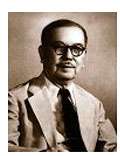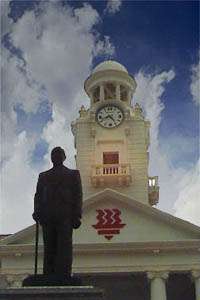Tan Kah Kee
| Tan Kah Kee | |
|---|---|
 | |
| Born |
21 October 1874 Jimei, Tong'an County, Xiamen, Fujian, Qing Empire |
| Died |
12 August 1961 (aged 86) Beijing, China |
| Other names | Chen Jiageng |
| Occupation | Businessman |
| Known for |
|
| Spouse(s) | Teo Po Ke |
| Children | Tan Ai Leh (daughter) |
| Parent(s) | Tan Kee Peck (father) |
| Relatives |
Tan Keng Hian (younger brother) Lee Kong Chian (son-in-law) |
| Tan Kah Kee | |||||||||||||||
| Traditional Chinese | 陳嘉庚 | ||||||||||||||
|---|---|---|---|---|---|---|---|---|---|---|---|---|---|---|---|
| Simplified Chinese | 陈嘉庚 | ||||||||||||||
| |||||||||||||||
Tan Kah Kee or Chen Jiageng (21 October 1874 – 12 August 1961) was a Chinese businessman, community leader and philanthropist active in Southeast Asia, Hong Kong, and various Chinese cities such as Shanghai, Xiamen, and Guangzhou. He was a prominent figure in the overseas Chinese community of Southeast Asia in the 20th century, and was responsible for gathering much support from the community to aid China in major events such as the Xinhai Revolution (1911), the Kuomintang's Northern Expedition (1926–28), and the Second Sino-Japanese War (1937–45). Apart from donating most of his assets and earnings to aid China in those major events, Tan also helped to set up funds in Southeast Asia and Hong Kong, and contributed heavily to the establishment of several schools in Southeast Asia and Fujian, including Xiamen University.
In recognition of Tan's contributions to education and society throughout his lifetime, there are places and establishments in China and Southeast Asia named after Tan or built to commemorate him, including: the Tan Kah Kee Memorial Museum in Tan's hometown in Jimei; the Tan Kah Kee Foundation, which offers postgraduate scholarships; the Tan Kah Kee MRT Station along the Downtown MRT Line in Singapore.
The asteroid 2963 Chen Jiageng is named after him.
Life
Tan was born in Xiamen, Fujian, China in 1874, towards the end of the Qing dynasty. In 1890, at the age of 16, he travelled to Singapore to help his father, who owned a rice trading business there. In 1903, after the collapse of his father's business, Tan started his own company and built a business empire from rubber plantations, manufacturing, sawmills, canneries, real estate, import and export brokerage, ocean transport and rice trading. Being proficient in his mother tongue Hokkien, he achieved much success doing business in Singapore as Hokkien was an important business language of Singapore throughout much of the 19th as well as 20th century. His business was at its prime from 1912–14, when he was known as the "Henry Ford of the Malaya community".
Tan took a leading role amongst the 110 founding members of Tao Nan School in Singapore.[1] In 1919, he set up The Chinese High School (now the High School Section of Hwa Chong Institution) in Singapore. Earlier, in 1918, he established the Jimei Schools (now Jimei University) in Xiamen. In 1921, he set up Xiamen University and financially supported it until the Nationalist Government of the Republic of China took over in 1937. In 1920, Tan married his daughter, Tan Ai Leh, to Lee Kong Chian, his protégé, who later also became a well-known businessman and philanthropist.
Tan was one of the prominent ethnic Chinese to financially support Chinese efforts in the Second Sino-Japanese War. He organised many relief funds under his name, one of which alone managed to raise ten million Straits dollars in 1937. He was also a participant in the Legislative Yuan of the Nationalist Government in Chongqing. After the Japanese invaded and occupied Malaya and Singapore in 1942, these contributors were defined as "undesirables" and were subjected to systematic extermination in the Sook Ching Massacre, but Tan survived because he went into hiding in Java, Indonesia. Tan strongly rejected proposals to attempt to negotiate with the Japanese, regarding any such attempts as characteristic of a hanjian (a Chinese term for race traitor), and attempted to dissuade Wang Jingwei from such activities. He also exercised considerable effort against the governor of Fujian, Chen Yi, for perceived maladministration.[2]
In 1943, while taking refuge in Java, Tan began writing his memoirs, The Memoirs of an Overseas Chinese of the Southern Ocean (traditional Chinese: 南僑回憶錄; simplified Chinese: 南侨回忆录; pinyin: Nánqiáo Huíyìlù), which later became an important document of the history of the overseas Chinese in Southeast Asia.
Tan was the de facto leader of the Chinese community in Singapore, serving as chairman of the Chinese Chamber of Commerce and helping to organise the Hokkien clan association. However, he lost this role when the Chinese Civil War divided Singapore's Chinese community into Communist and Kuomintang sympathisers. Tan was a Communist supporter because he was disillusioned with the corruption within the Kuomintang. After the Communist victory in China and the founding of the People's Republic of China in 1949, Tan tried to return to Singapore in 1950, but was denied entry by the British colonial authorities, who were concerned about communist influence in Singapore and Malaya. He then moved permanently to China and served in numerous positions in the Chinese Communist Party.
Tan died in 1961 in Beijing and was given a state funeral by the Chinese government. In Singapore, the Tan Kah Kee Scholarship Fund, which later became known as the Tan Kah Kee Foundation, was established in memory of this philanthropy.
Image gallery
- Statue of Tan Kah Kee in front of a memorial hall in Xiamen University, Xiamen, Fujian, China.
 Statue of Tan Kah Kee in front of the clock tower of Hwa Chong Institution, Singapore.
Statue of Tan Kah Kee in front of the clock tower of Hwa Chong Institution, Singapore. Head statue of Tan Kah Kee at the foyer of Nan Chiau High School, Singapore
Head statue of Tan Kah Kee at the foyer of Nan Chiau High School, Singapore- Kah Kee Park and Turtle Garden in Jimei, Xiamen, Fujian, China.
See also
- Tan Kah Kee MRT Station, a train station in Singapore named after Tan Kah Kee
- Lee Kong Chian, Tan Kah Kee's son-in-law, who was also a well-known businessman and philanthropist
References
Footnotes
- ↑ Brief history of Nan Chiau, The Herencia, Retrieved 12 December 2015
- ↑ Boorman, Howard L. (1968). "Fei Hsiao-t'ung". Biographical Dictionary of Republican China. II. New York: Columbia University Press. p. 252.
General references
- Jiageng Chen; A. H. C. Ward; Raymond W. Chu; Janet W. Salaff (1994). The Memoirs of Tan Kah Kee. Singapore: Singapore University Press. p. 366.
- Yong Chin Fatt (1989). Tan Kah Kee: The Making of an Overseas Chinese Legend. Singapore: Oxford University Press.
- Tan Kah Kee (1996). The Memoirs of an Overseas Chinese of the South Seas (in Chinese). Taiyuan: Shanxi Guji chuban she.
- Bonny Tan (22 January 1999). "Tan Kah Kee". Singapore Infopedia. Singapore National Library Board. Retrieved 30 July 2009.
External links
| Library resources about Tan Kah Kee |
| Wikimedia Commons has media related to Tan Kah Kee. |